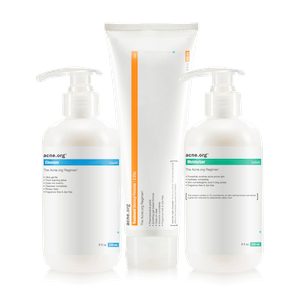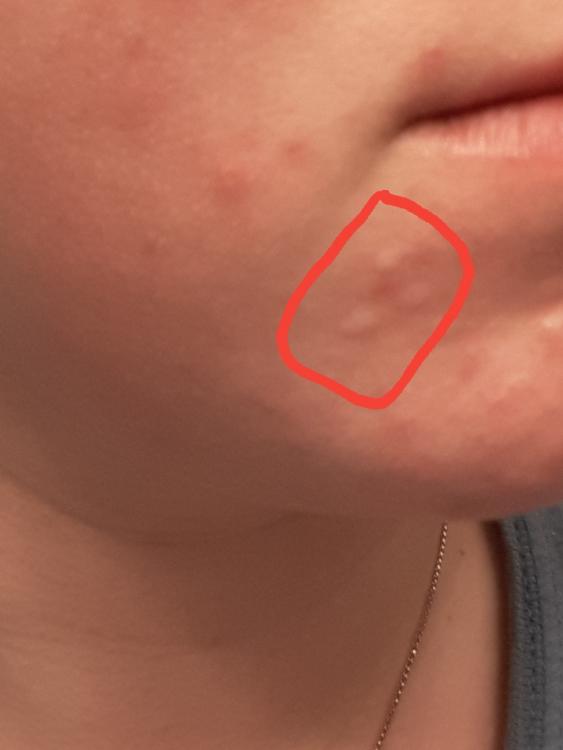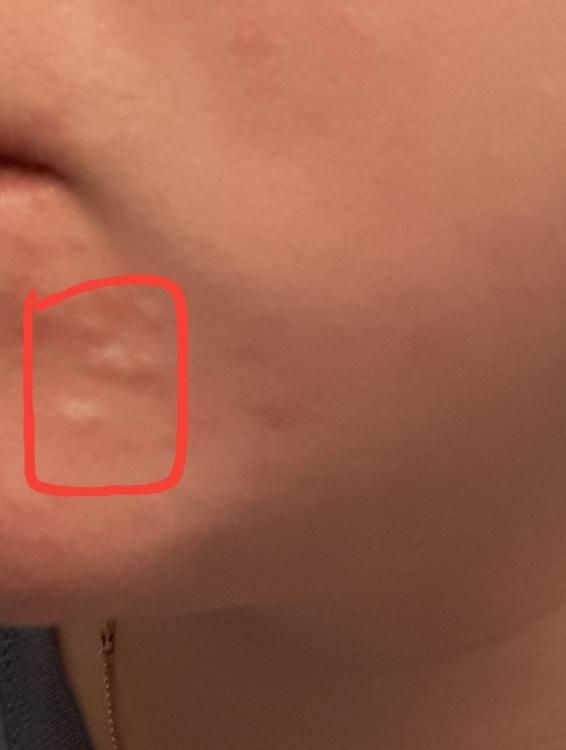Hi everyone I'm new here. I been dealing with chin acne for years and I had residual bumps from it. 3 on one side and 2 on the other. I had co2 laser 2 years ago but it didn't help. Bumps came back with hypopigmentation! Plastic surgeon said there's nothing more he can do. He said if he injected them then they could become indented which would apparently look worse but I'm seriously questioning if it would. I been referred to a derm to address my acne because they're unsure if it's hormone or rosacea related. Derm is booked for up to a year so I don't know if there are any other procedures that can help these stupid bumps I can't cover-up. In the meantime, has anyone deal with this? Is there ANYTHING out there that can help get rid of these bumps? Thanks in advance. I attached pics.
*Not an expert*
I'm not surprised laser didn't flatten them, it's not really supposed to I believe?
Silicone can flatten raised scars and is cheap. Sheets or gel... gel is more convenient. Apply it twice daily.
Yes they could become indented if he injects them but it may then be easier to raise them with treatments such as microneedling and/or filler. Someone more knowledgeable on that should confirm this. ![]()
I have seen these treated a few ways the most successful is kedoid like treatments as ubreakable said where you shrink the area of concern, and possibly subcise and use filler if there is any indent. They can be lasered or TCA used only once you shrink the bump more. See a qualified derm or plastic with experience in Keloid like scarring.
See the FAQ, first post under scar solutions sub, then goto the scar section with pictures and it gives several treatments to try.
Keloid and HypertrophicScarsAre the Result of Chronic Inflammation in the Reticular Dermis.
Abstract
Keloidsandhypertrophicscarsarecausedbycutaneousinjuryandirritation,includingtrauma,insectbite,burn,surgery,vaccination,skinpiercing,acne,folliculitis,chickenpox,andherpeszosterinfection.Notably,superficialinjuriesthatdonotreachthereticulardermisnevercausekeloidalandhypertrophicscarring.Thissuggeststhatthesepathologicalscarsareduetoinjurytothisskinlayerandthesubsequentaberrantwoundhealingtherein.Thelatterischaracterizedbycontinuousandhistologicallylocalizedinflammation.Asaresult,thereticularlayerofkeloidsandhypertrophicscarscontainsinflammatorycells,increasednumbersoffibroblasts,newlyformedbloodvessels,andcollagendeposits.Moreover,proinflammatoryfactors,suchasinterleukin (IL)-1,IL-1,IL-6,andtumornecrosisfactor-areupregulatedinkeloidtissues,whichsuggeststhat,inpatientswithkeloids,proinflammatorygenesintheskinaresensitivetotrauma.Thismaypromotechronicinflammation,whichinturnmaycausetheinvasivegrowthofkeloids.Inaddition,theupregulationofproinflammatoryfactorsinpathologicalscarssuggeststhat,ratherthanbeingskintumors,keloidsandhypertrophicscarsareinflammatorydisordersofskin,specificallyinflammatorydisordersofthereticulardermis.Variousexternalandinternalpost-woundingstimulimaypromotereticularinflammation.Thenatureofthesestimulimostlikelyshapesthecharacteristics,quantity,andcourseofkeloidsandhypertrophicscars.Specifically,itislikelythattheintensity,frequency,anddurationofthesestimulideterminehowquicklythescarsappear,thedirectionandspeedofgrowth,andtheintensityofsymptoms.Theseproinflammatorystimuliincludeavarietyoflocal,systemic,andgeneticfactors.Theseobservationstogethersuggestthattheclinicaldifferencesbetweenkeloidsandhypertrophicscarsmerelyreflectdifferencesintheintensity,frequency,anddurationoftheinflammationofthereticulardermis.Atpresent,physicianscannot (oratleastfinditverydifficultto)controlsystemicandgeneticriskfactorsofkeloidsandhypertrophicscars.However,theycanuseanumberoftreatmentmodalitiesthatall,interestingly,actbyreducinginflammation.Theyincludecorticosteroidinjection/tape/ointment,radiotherapy,cryotherapy,compressiontherapy,stabilizationtherapy,5-fluorouracil (5-FU)therapy,andsurgicalmethodsthatreduceskintension.
KEYWORDS:
hypertrophic scar; keloid; radiation; steroid tape; surgery
Thanks everyone for your replies. I was feeling quite hopeless like nothing would work for these things. I'll try silicone gel (any recommendations?). Will it work though on old scars? I live in Canada and I'm on a long wait list to see a derm. Also, what is subcise? I read online but maybe someone here can give me a better understanding on how it works.
Also, wow I'm annoyed that they recommended co2 for these if previous poster said they'e not supposed to flatten them. He seemed so confident it would. And I was never told of risks, ie hypopigmentation. Definitely doing my research next time.
stratacel and strataderm sold in the USA and Europe. Google it. Dr's recommend that one. No it probably won't work on older scars. This is why we suggested the kenalog or steriod injections to shrink them. Laser would then be used after for resurfacing. IF there becomes a pit that is why we said subcision and filler as sometimes the doctors are overly eager and inject too much. They can do a little at a time. Another treatment for kenalog is to do co2 laser and put kenalog in the channels made. Goto someone with experience in keloid scars and has seen many cases. Ask them first how they would treat, they should be knowledgeable unless they are faking it.
The reservation with the co2 was some doctors are just really bad with lasers and are not experts using them. They just use standard settings and are not proficient. Few Drs do ablative laser these days, so it's hard to find a doctor who will resurface and not do fractional co2 on scars.
I'll be referred to a couple Derms tomorrow at my Dr appt. So hopefully 1 of them can help me with this issue. Can anyone tell me what type of questions I can ask them? I really don't want them to f up my face worse so I want to make sure I feel confident with the derm I choose. Also, if they did indent, does anyone know what it'd look like exactly? Would it be the same size as the bump, larger or coulda large portion of my skin be sunken in? Sorry im new to this so i really have no clue what to expect.... thanks
Meant to add in that I'll be asking them about the injections to hopefully flatten the bumps
Ask them about steroid injections for the height of your scar issues or what treatments they would suggest. Say your main concern is making ithe bump level with your skin.
Ask them their expereince with keloid scars and how they treat them.
Ask them if they are a aesthetics doctor, many general derms just say live with it.
It looks like a small pit, but again this can be fixed with filler, ... this is from injecting too much material and can happen, ... some doctors inject a tiny bit diluted and make you come back for a 2nd appointment to avoid this. Sunken in yes if there is too much, but it's easy to fix with filler, or heals naturally over many months.
Please read the FAQ top of the scar solutions sub, first post, goto the skin section and hypopigmentation (lots of options there), also goto keloids section and see the raised scars for some ideas for your scars at the top of the FAQ, I also want you to read at the bottom the doctor recommendations questions to ask a doctor.
Thanks,
BA
I wanted to update... been to 2 derm and neither recommended steroid because they are worried about it leaving an indent. One derm recommended punch excision and told me to go on retinol for a few months to prepare my skin. I'm just so sick of dealing with this I'm just about to say f it and live with it already
On 6/3/2018 at 10:15 PM, Mountainsbaby13 said:I wanted to update... been to 2 derm and neither recommended steroid because they are worried about it leaving an indent. One derm recommended punch excision and told me to go on retinol for a few months to prepare my skin. I'm just so sick of dealing with this I'm just about to say f it and live with it already
I have had the same bumps on my chin for 30 years. I have done everything that can be cone on dark skin. fraxel helped a little and skin pen they are not completely gone. The best way to prevent them is to use retin a on pimple so that it won't leave the bump.
 Acne.org Products
Acne.org Products
